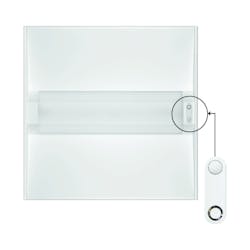A Contractor’s Guide to Luminaire Level Lighting Controls
Over the last 20 years, LEDs have made lighting more efficient, smarter, and versatile. Luminaire level lighting controls (LLLCs) are helping to integrate these benefits into individual LED luminaires and redefine the way we think about lighting control in offices, classrooms, conference rooms, and more. While wired, fixture-level control has been possible for more than a decade, wireless technology puts flexible, adjustable, smart control well within reach for most projects from a budgetary and scheduling standpoint.
What do we mean by LLLCs?
From an industry standpoint, LLLCs are wireless lighting control devices integrated directly into a luminaire, typically by the manufacturer. Equipped with this device, the luminaire can be individually controlled (or digitally grouped) to create lighting zones that meet the customer’s specific needs.
Some manufacturers’ LLLC devices include occupancy sensors and daylight sensors that can either be built into the luminaire by the manufacturer or provided as part of a retrofit kit to update existing lighting systems in field installations. Using these technologies, sensor data can be used to tailor system setup to better reflect user patterns, manage energy use, and make the most of natural daylight in a space.
Simple design, wiring, and installation
For the contractor, using a digital solution — LLLC devices or digital drivers — simplifies the wiring and installation of controls and luminaires. Power wiring can be run independently of control wiring, which maximizes flexibility for the customer. Luminaire zoning can be determined at any time, even after the installation is complete. It can be just as easily adjusted from an app or dashboard with no new wiring. In addition, LLLCs do not require a control wire to be run to the luminaire, which is necessary for wired applications. This can save time and further reduce the amount of material required on the job.
When a project uses wired, 0-10V drivers, contractors need to know exactly how the luminaire will be zoned before the job is installed. This is important because the power and control wire must be zoned the same way. If the lighting needs to be rezoned, the project faces rewiring and additional costs. Complex space layouts with a large number of zones can make it especially difficult to wire the luminaires correctly and make troubleshooting even more challenging. The result is a system with very little flexibility. With LLLCs, wiring mistakes are minimized, and zoning decisions can be made after the luminaires are installed.
When the LLLC devices incorporate sensor options – occupancy and/or daylight sensors – the luminaires can provide data to support advanced energy savings and other business decisions while simplifying installation. When you are using traditional, wired zone-control systems, occupancy sensors and/or daylight sensors may have to be installed for code compliance or to meet the client’s performance needs.
In comparison, when using a pre-installed LLLC that incorporates the sensors, you do not need additional, independent sensors. LLLCs eliminate extra steps and system complexity. There is also no extra time required for installing sensors, no need to associate those additional devices in the system, and less room for error.
Since these devices are pre-installed in the luminaire, driver compatibility is resolved before the luminaire is shipped. And as long as the LLLC works with the specified control system, you don’t have to worry about compatibility between the LLLC and the driver. Contractors can be confident the system can be installed and setup easily with limited callbacks.
This is a clear win for the contractor, who can bid the job more accurately and add value for their customers. But it is also a significant advantage to the building owner, occupant, and facilities team. By reducing wiring and expanding set-up options, as part of a digital lighting control solution, LLLCs can save time, lower operating cost, and deliver a more future-proof install. As electrical contractors face ongoing (or worsening) labor shortages, LLLCs contribute to simpler installations, reduced callbacks, and can increase the number of jobs a contractor can handle.
How are LLLCs commonly configured?
Since LLLC devices provide individual luminaire control and offer digital programming, there are a range of ways in which luminaires – or luminaire groups – can be controlled. Moreover, LLLC models have varying levels of sensing capability.
LLLC models are available with or without integral sensors and can be mixed and matched within a system. The advantage is that the customer only pays for the technology they need in the space and the contractor can have greater control over the bid. For example, an open office space with copious daylight may benefit from daylighting capabilities, but a conference room may be more functional with uniform lighting and not require the daylight sensor.
Energy codes likely still require an occupancy sensor that can either be included as part of the LLLC or be offered as a separate wireless sensor added to the bill of materials. These wireless sensors make it possible for the contractor to optimize the budget by ensuring the desired lighting system performance while minimizing extras that are not required by the customer. Regardless, the luminaires can be grouped in any configuration and easily regrouped if space use changes. LLLCs are important tools in the contactor's toolkit — part of a larger system that provides a wide range of flexible control options.
Flexibility over time
To deliver flexible, future-proof lighting control, it is important to design and deploy the right solution in the right space. For example, an LLLC-based solution may be ideal for the open-office areas in a space, while adjacent conference rooms can be best-served with more traditional zone control. The key is to have the right options (and flexible systems) to provide the desired control in each space. With an app-based control system, the contractor can make programming changes right from an app without even having to be in the space. Settings can be adjusted, lighting can be rezoned, or luminaires can be easily adjusted for a special event right from an app on a phone or tablet.
As part of a wireless control system, LLLCs will continue to simplify lighting control installation – contractors do not need to have all the project details defined before they start the job and can still be confident the customer has a system that meets their needs. The opportunity for enhanced lighting performance is a significant differentiator for the design-build contractor, who now enjoys a broader design palette and greater freedom to design lighting that meets the individual needs of every job. In a design-build scenario, the contractor must have confidence in the solution since the design often continues to develop as the project progresses. LLLCs can provide that confidence. As long as the LLLC works with the chosen control system, the job is off to the right start.
Craig Casey is a Building Science Leader at Lutron. Well-known in the lighting industry, he conducts applied research on energy and the human benefits of lighting and daylighting controls. He has presented multiple times at the Illuminating Engineering Society (IES)’s Annual Conference and LightFair. Craig sits on the Daylight Metrics Committee of the IES. He received the IES Presidential Award for chairing the 2015 Conference Steering Committee. Craig holds Bachelor and Master of Architectural Engineering degrees from Penn State and is currently pursuing his PhD.
About the Author
Craig Casey
Senior Building Science Engineer
Casey is a senior building science engineer with Lutron Electronics Co., Inc. in Coopersburg, Pa. He is active in the Illuminating Engineering Society’s (IES) Energy Management Lighting Controls Subcommittee. He can be reached at [email protected].


